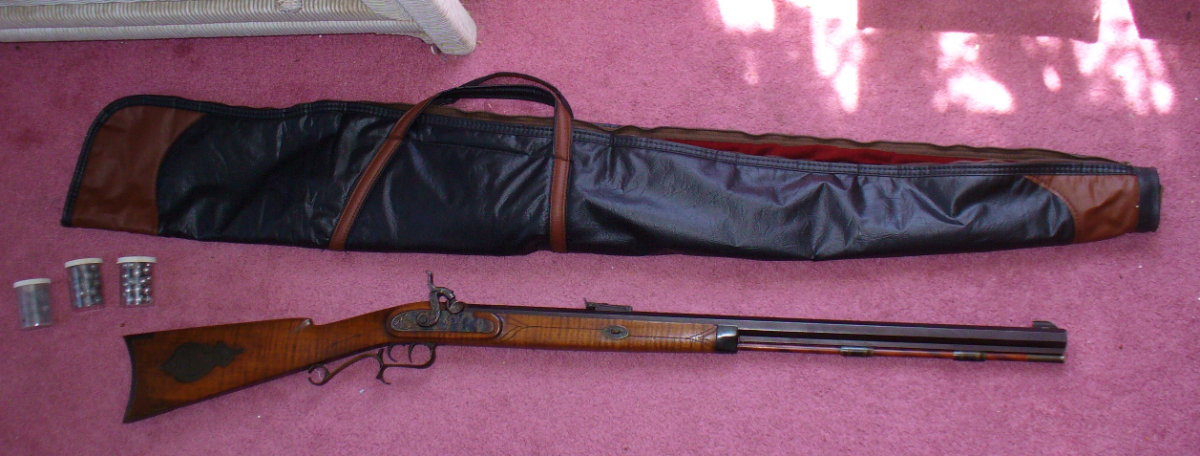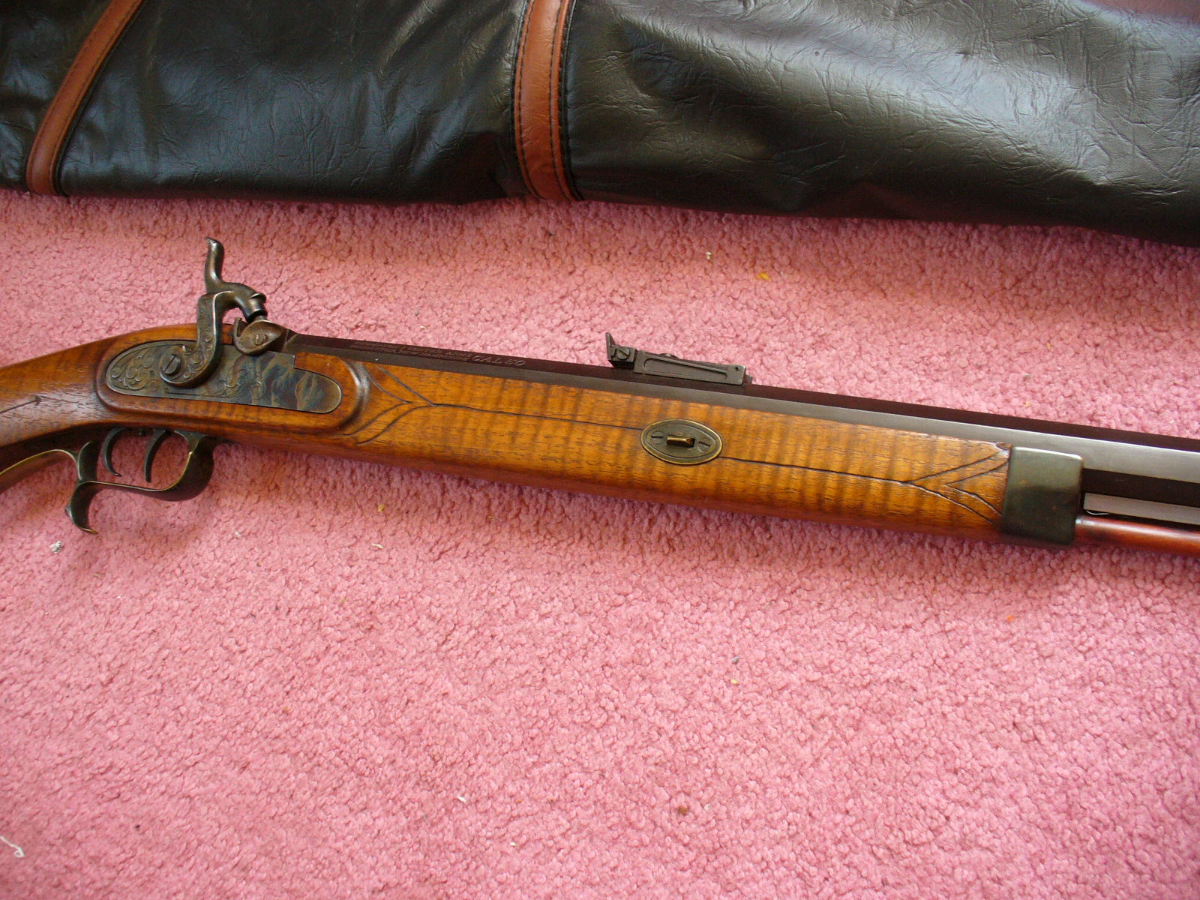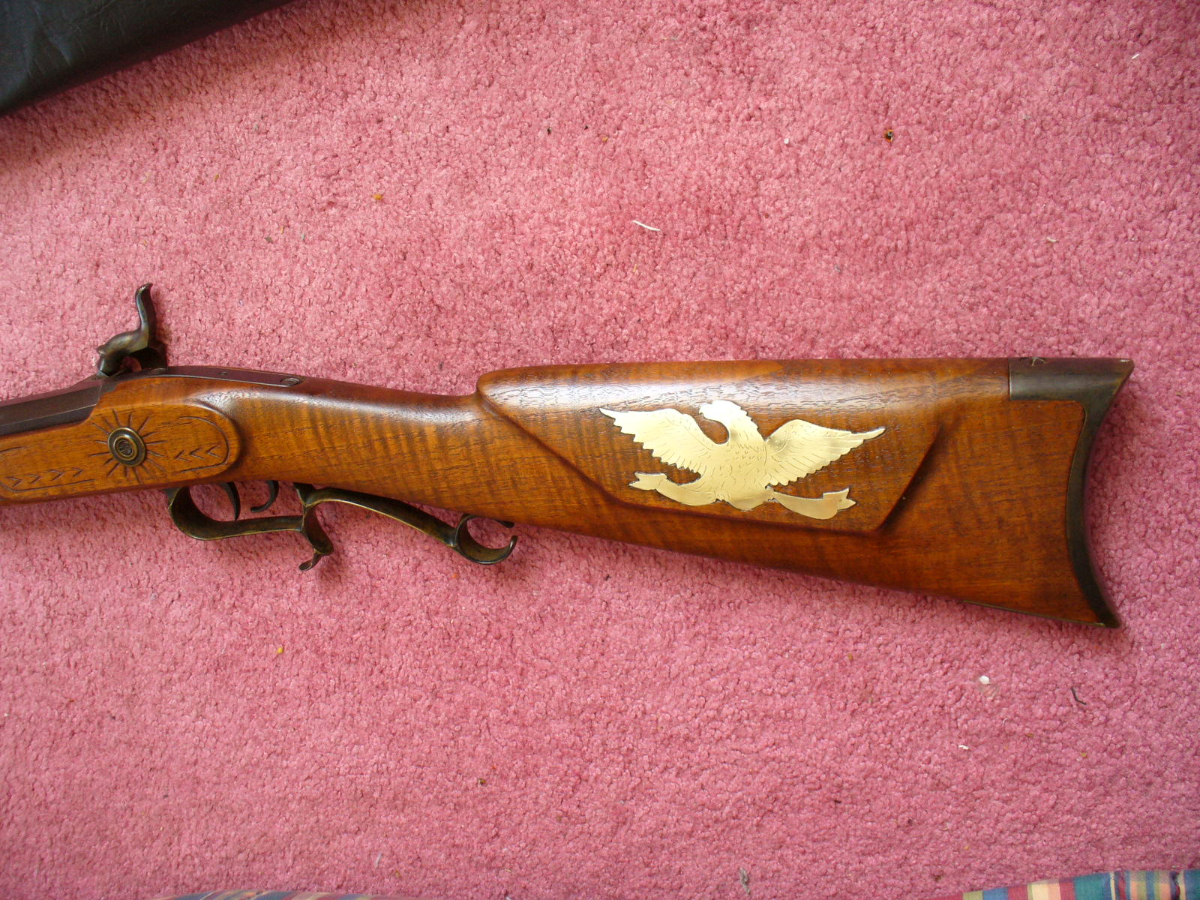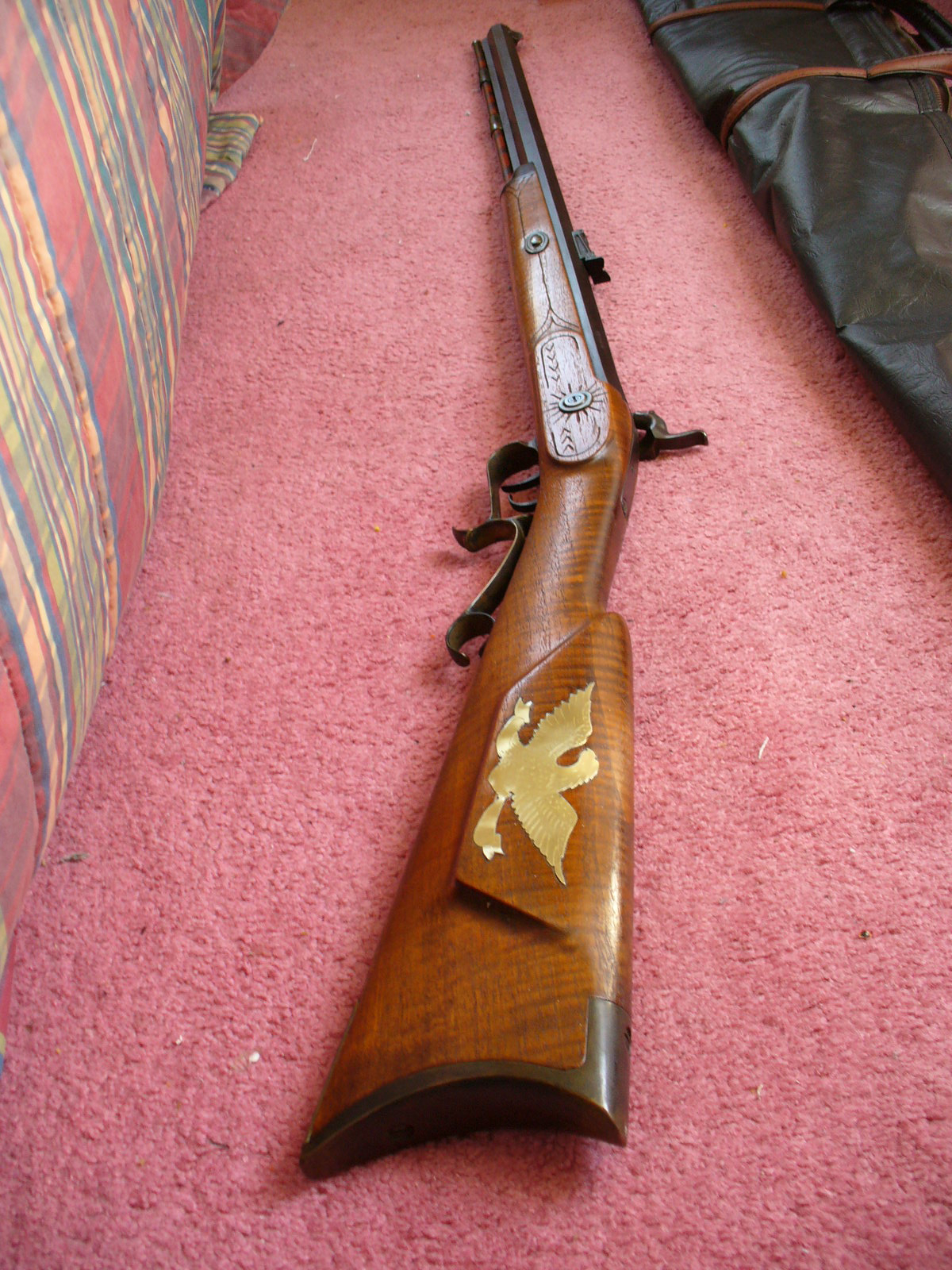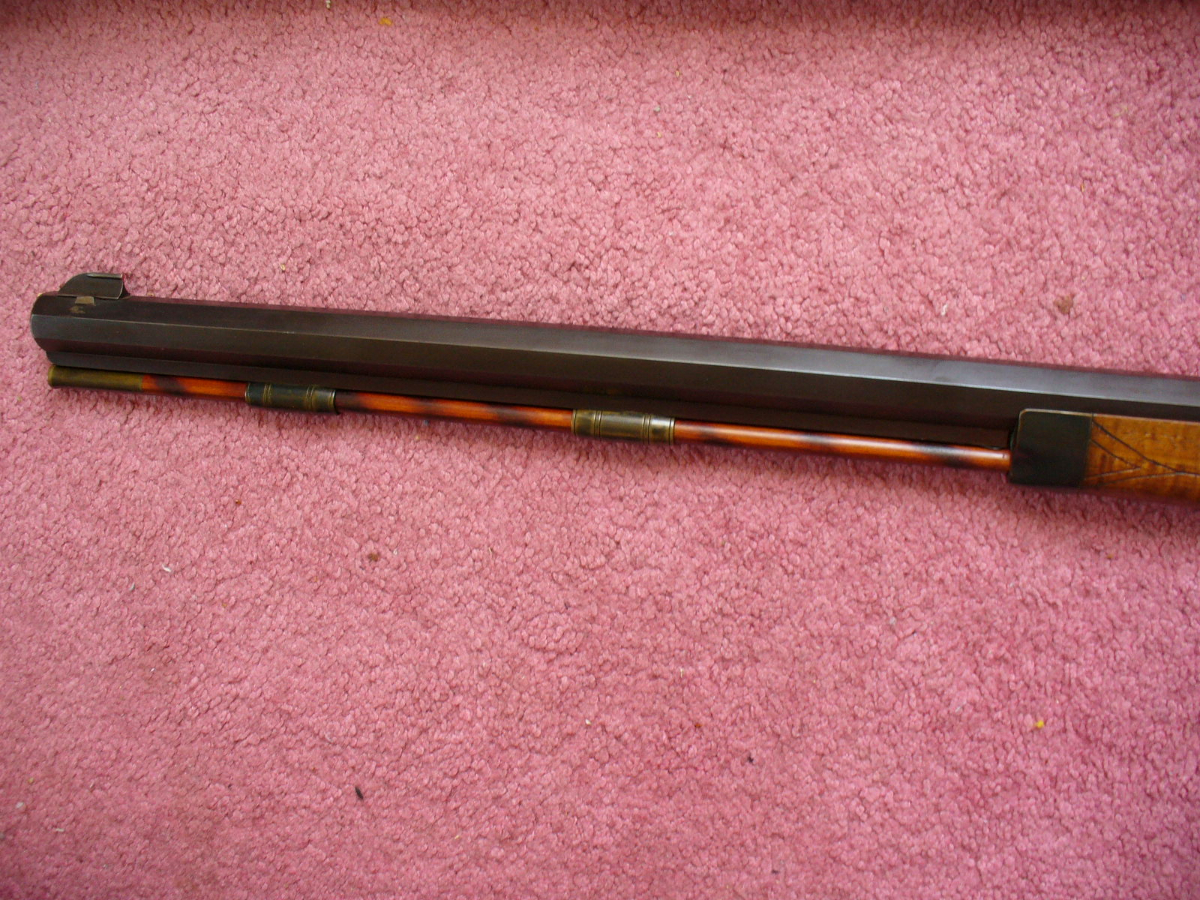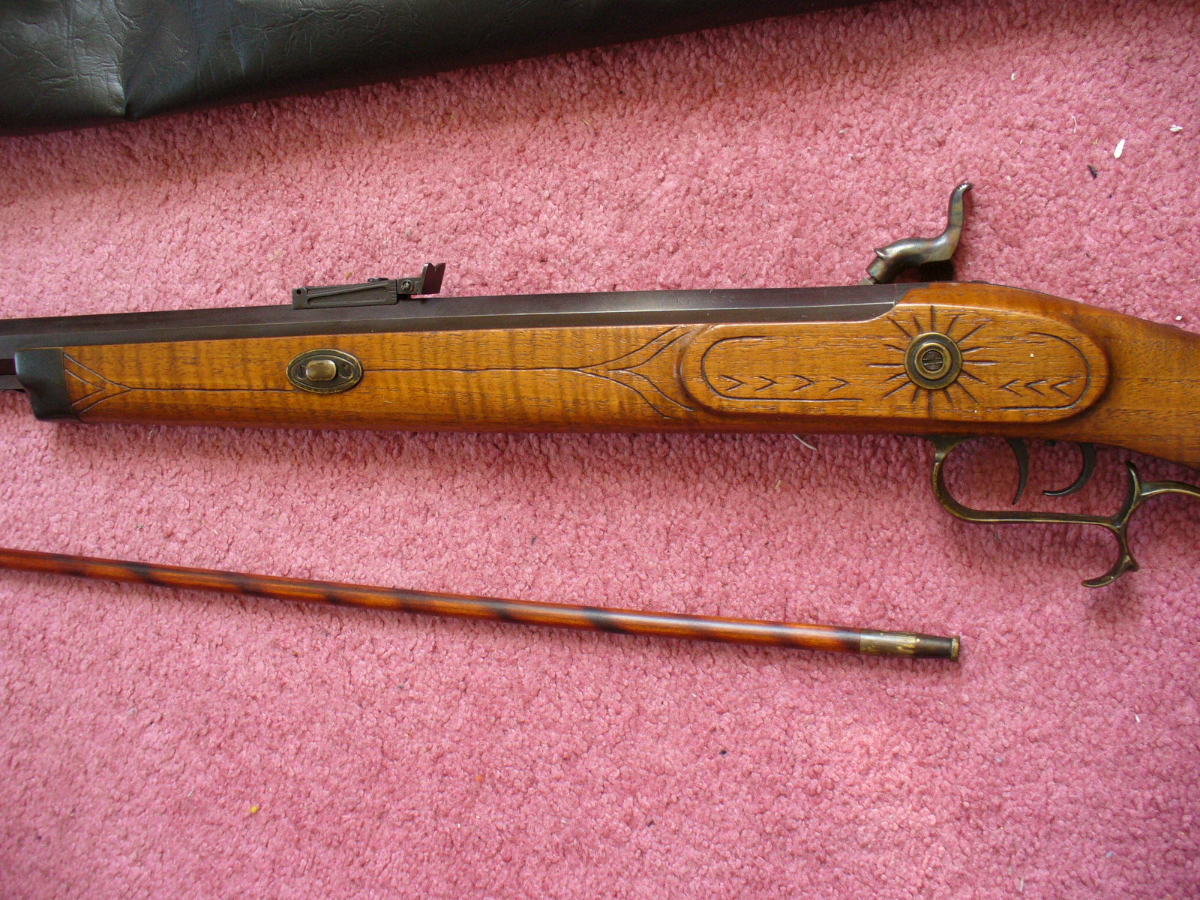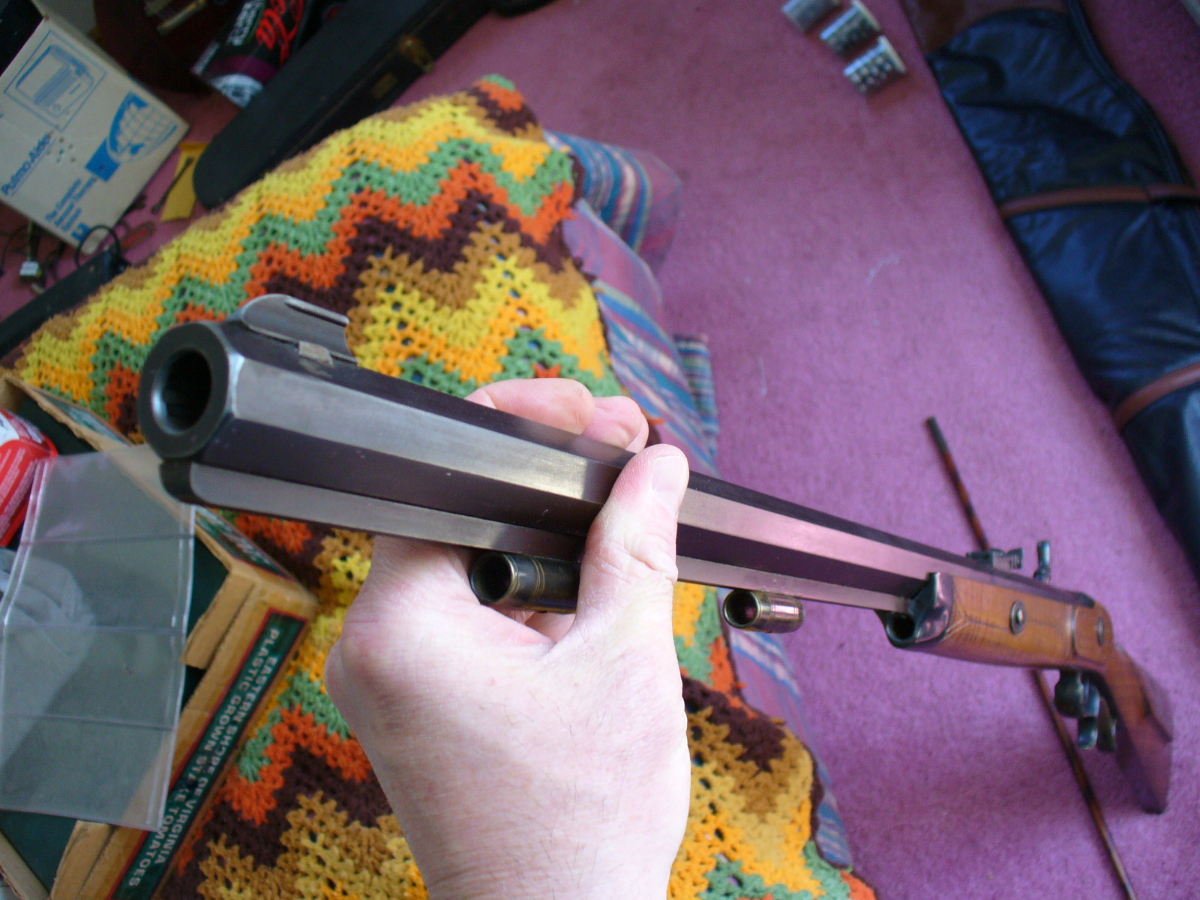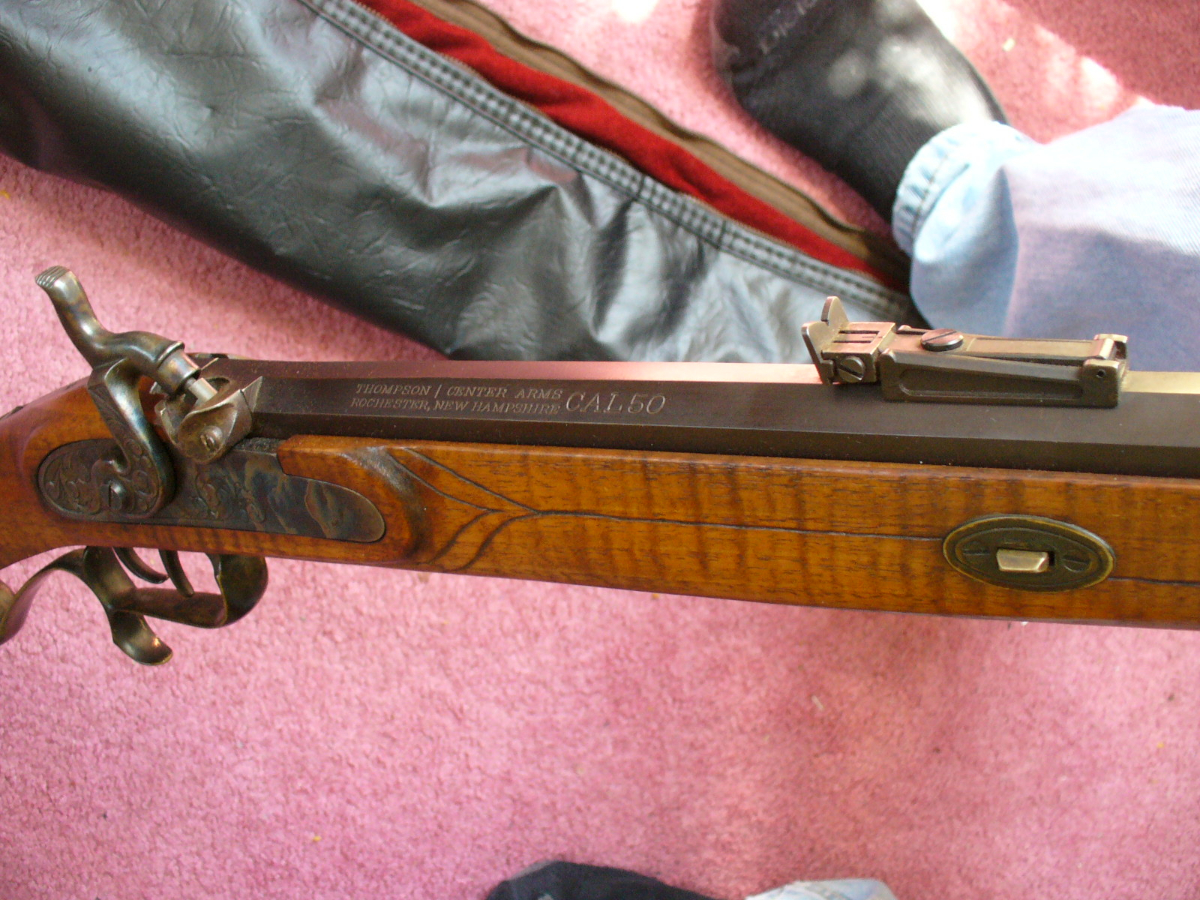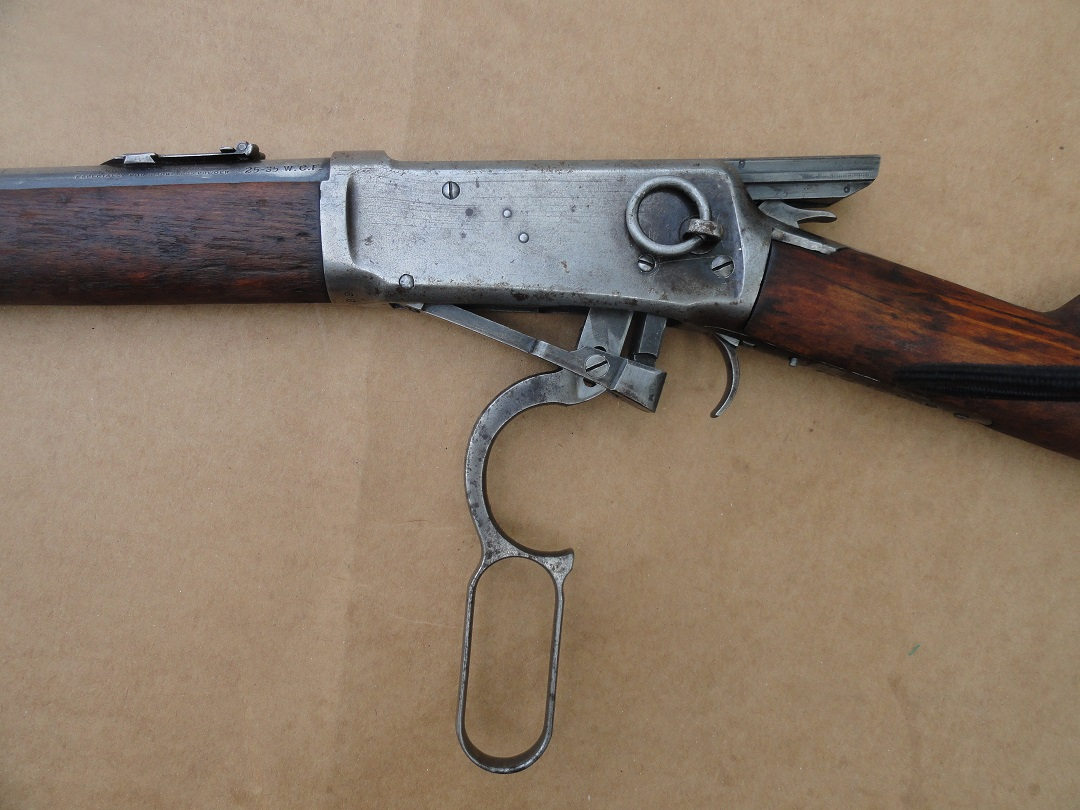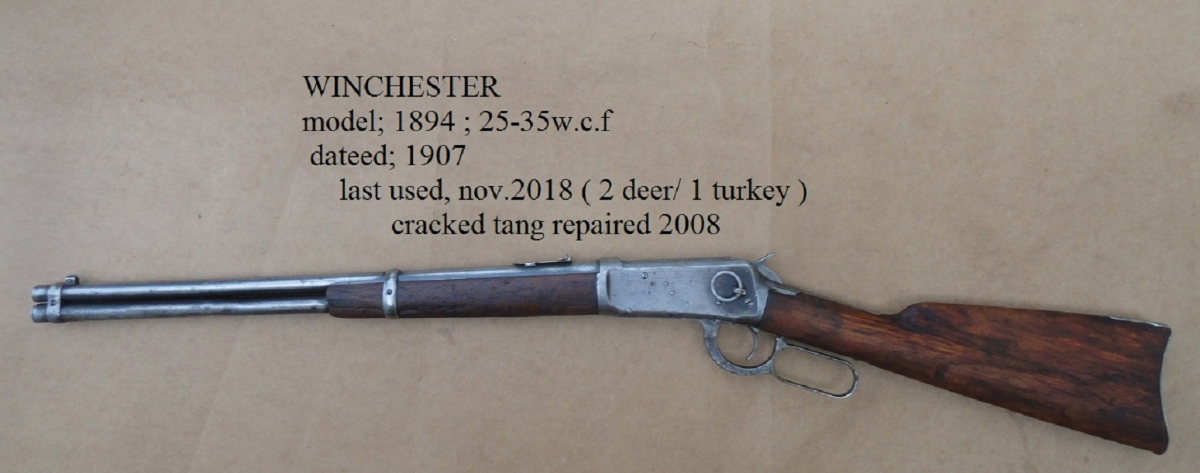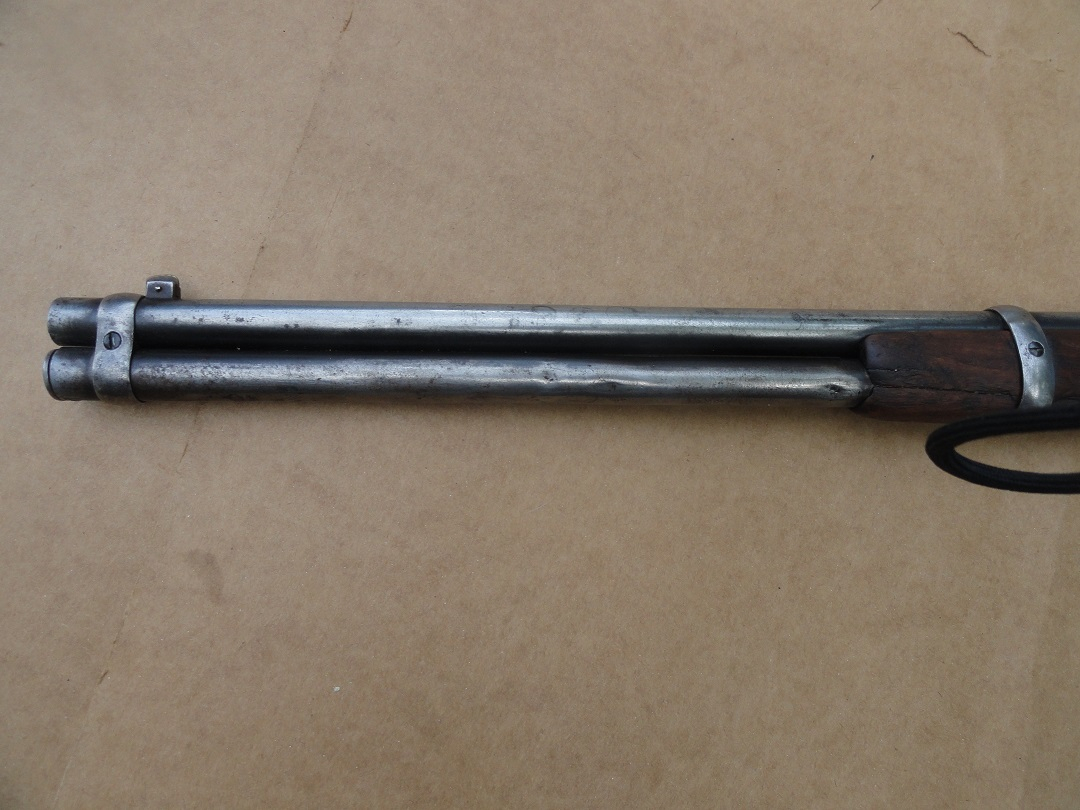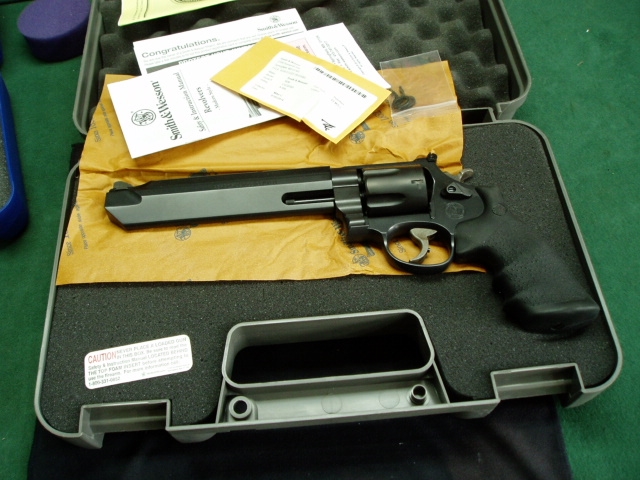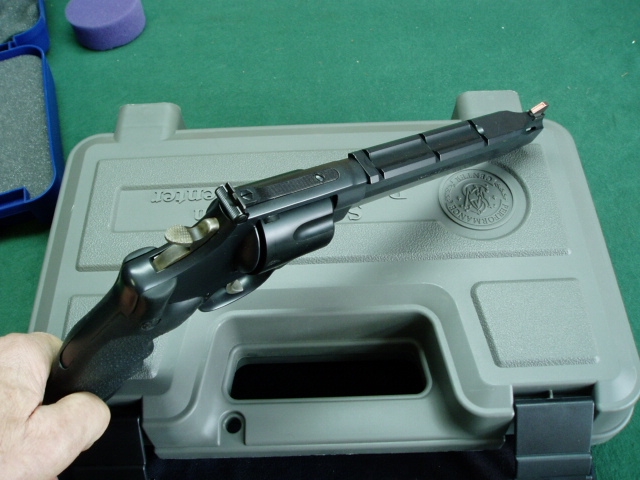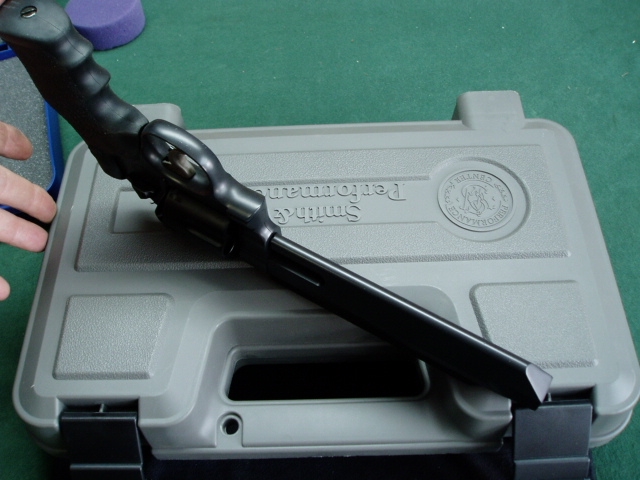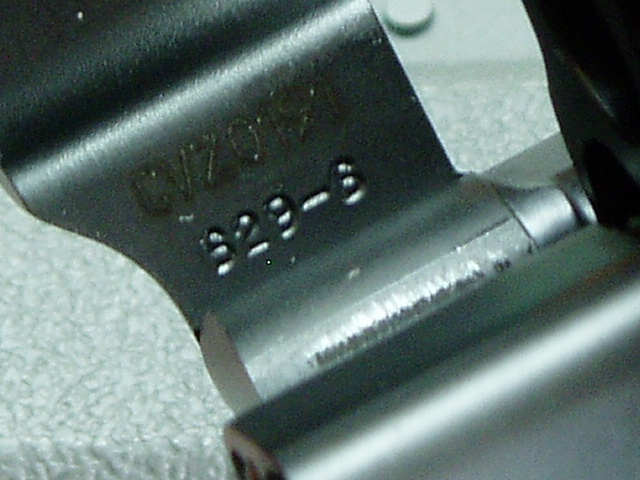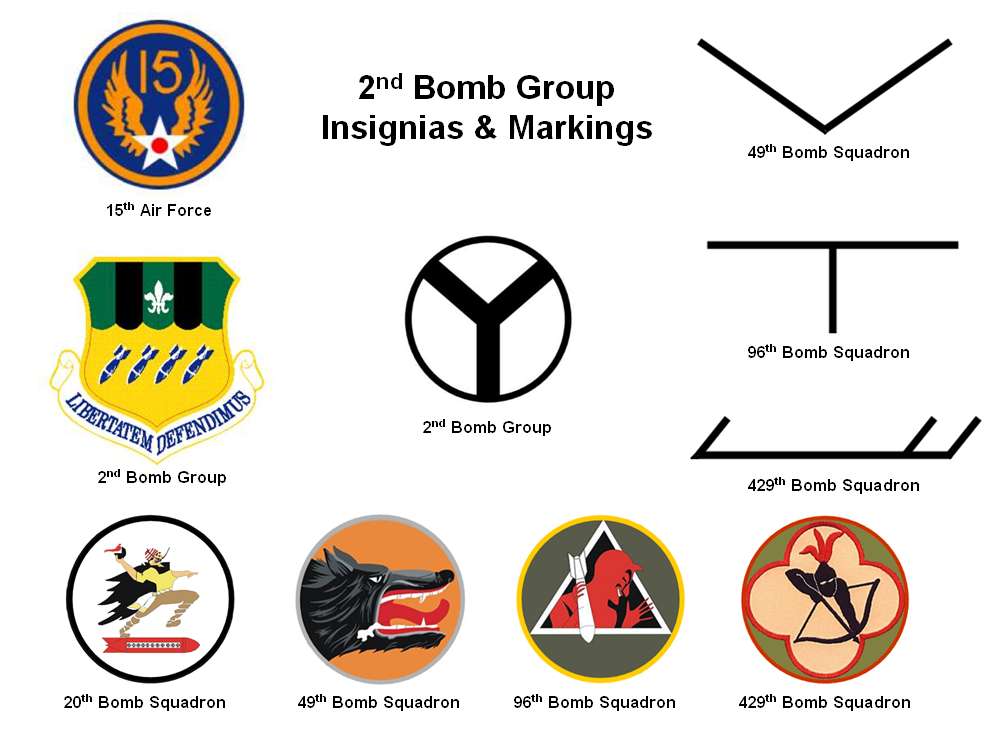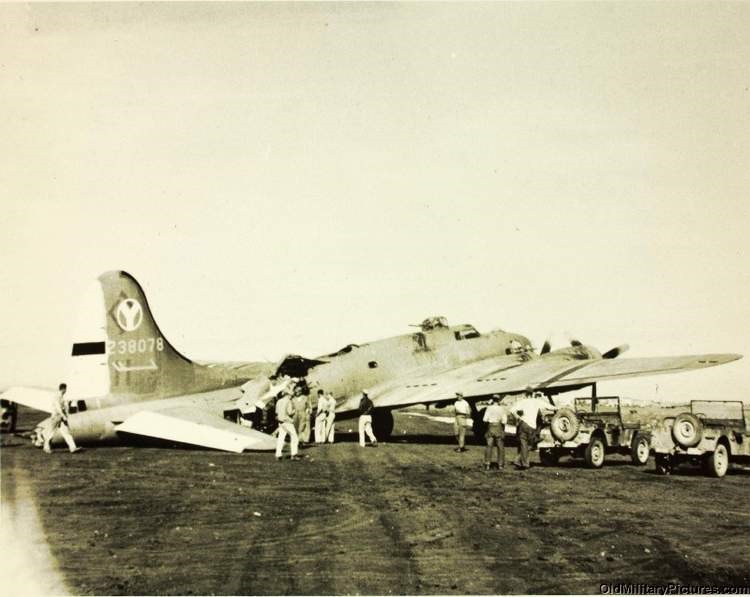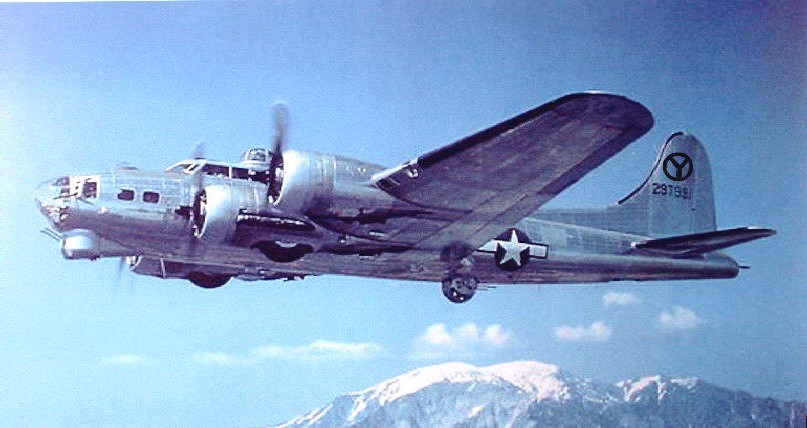Month: July 2019
I ended up going down this rabbit hole Saturday night late. I was searching for information about a B-17 pilot from Alabama who was shot down over Romania in February of ’45. He was the only survivor out of his ship. His chute was on fire and he thought he was a “goner”. As his chute disappeared and his velocity increased towards earth, death was not meant for him at that time. He landed in a sedimentation pond at the lower end of field and stuck up to his neck in mud. Before he could get out, the Germans were upon him. He was taken into captivity and moved twice in front of the advancing Russians. At the third camp he awoke one morning to find all the Germans gone and the gates open. Thinking it might be a trap, he and the other POWs stayed put until the Ruskies arrived. Two weeks later he was back in England. This is not the story I was looking for, but this is one HELLUVA story about some men that nursed a damaged ship 600 miles back to Italy using engine power to steer and eventually land the plane.The Saga of “Sweet Pea”
|
||||
Someday I will try to do this myself. But is getting harder & harder to find a good shooter for sale in my limited Retired Teacher Budget! Grumpy
PS Here is some more information about THE Round used at the height of the British Empire.
.577/450 Martini–Henry
Jump to navigationJump to search
| .577/450 Martini–Henry | ||||||||
|---|---|---|---|---|---|---|---|---|
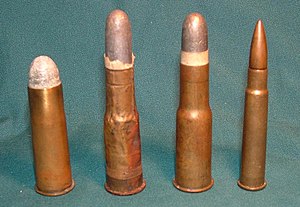
.577 Snider, two .577/450 Martini–Henry (coiled brass & drawn brass) and .303 British cartridges.
|
||||||||
| Place of origin | United Kingdom | |||||||
| Service history | ||||||||
| Used by | British Empire | |||||||
| Wars | Anglo-Zulu War, Mahdist War | |||||||
| Production history | ||||||||
| Designed | 1871 | |||||||
| Specifications | ||||||||
| Parent case | .577 Snider | |||||||
| Bullet diameter | .455 in (11.6 mm) | |||||||
| Neck diameter | .487 in (12.4 mm) | |||||||
| Shoulder diameter | .628 in (16.0 mm) | |||||||
| Base diameter | .668 in (17.0 mm) | |||||||
| Rim diameter | .746 in (18.9 mm) | |||||||
| Rim thickness | .05 in (1.3 mm) | |||||||
| Case length | 2.34 in (59 mm) | |||||||
| Overall length | 3.12 in (79 mm) | |||||||
| Ballistic performance | ||||||||
|
||||||||
| Source(s): Cartridges of the World.[1] | ||||||||
The .577/450 Martini–Henry is a black powder, centrefire rifle cartridge, it was the standard British service cartridge from the early 1870s that went through two changes from the original brass foil wrapped case (with 14 parts) to the drawn brass of two parts, the case and the primer. The .577/450 Martini–Henry was introduced with the Martini–Henry, in service it succeeded the .577 Snider cartridge and was used by all arms of the British armed forces as well British colonial forces throughout the British Empire until it was itself succeeded by the .303 British cartridge after unsuccessful trial of a .402 calibre [2]
Contents
Design[edit]
The .577/450 Martini–Henry is a rimmed, bottlenecked centerfire rifle cartridge derived from the .577 Snider, it was lengthened and bottlenecked. The .577/450 Martini–Henry was developed for use in the single shot Martini–Henry service rifle, originally loaded with blackpowder later it used cordite propellant.[1]
Rifle cartridges[edit]
The various rifle cartridges fired a 480 gr (31 g) bullet made of an alloy of 1 part tin and 12 parts lead, driven by 85 gr (5.5 g) of RFG2 blackpowder and later 35.8 gr (2.32 g) of cordite size 3 at a muzzle velocity of 1,300 to 1,350 ft/s (400 to 410 m/s).[1][3][4]
Coiled brass cases[edit]
The first .577/450 Martini–Henry rifle cartridge, the Cartridge S.A. Ball Rifle Breech-Loading Martini Henry Mark I, was made of coiled brass sheet .003 in (0.076 mm) thick with a strengthening strip of brass inside the coil and the body of the cartridge was riveted to the iron base disc and lined with thin white tissue paper. The smooth sided bullet was paper-patched with a thick cake of beeswax below the bullet with two cardboard discs above and a single one below.[5][6]
As a matter of economy, the Mark I was replaced by the Cartridge S.A. Ball Rifle Breech-Loading Martini Henry Mark IIwhich had a slightly thicker .004 in (0.10 mm) wall, no strengthening strip and a slightly longer base cap was added. The Mark II had a tendency to split at the base, so the Cartridge S.A. Ball Martini Henry Rifle Rolled Case Mark III was developed which had two layers of .004 in brass overlapped by .5 in (13 mm) with a .004 in brass strengthening strip with a small sight hole punched in the outer coil as a visual check that the strip was correctly placed and an inner and outer base cap turned over at the base.[6][7]
As a result of complaints about the recoil compared to the Snider cartridge, Woolwich developed a lighter loading with a 410 gr (27 g) bullet driven by 80 gr (5.2 g) of blackpowder, the Cartridge S.A. Ball Martini Henry Rifle Rolled Case Mark IV. The Mark IV is visually identical to the Mark III and once removed from its bundle can only be identified by weight, it was produced in batches between 1873 and 1880 by which time complaints about the recoil had ceased, presumably as soldiers became accustomed to it, and later production reverted to the Mark III.[5][6]
Drawn brass cases & cordite loadings[edit]
In service the coiled brass cases proved to be fragile and prone to sticking in the chamber so in 1885 a solid drawn brass case was introduced, the Cartridge S.A. Ball Martini Henry Rifle Solid Case Mark I, this was soon replaced by the Cartridge S.A. Ball Martini Henry Rifle Solid Case Mark II with a paper patch that did not extend so far up the bullet. The Mark II cartridge was replaced in British Army service by the .303 British from 1889, but remained in the service of colonial forces for many years.[3][4]
In 1902 the use of cordite was approved for use in the .577/450 cartridge and the Cartridge S.A. Ball Martini Henry Rifle Solid Case Cordite Mark I was introduced the same year, with a similar cartridge case and bullet, but loaded with cordite.[4]
Carbine cartridges[edit]
A reduced power load was produced for use in carbines, firing a 410 gr (27 g) bullet of the same alloy driven by 70 gr (4.5 g). The lighter carbine loading was less accurate, had a shorter range and less stopping power, but the two were interchangeable.[3][8]
Coiled brass cases[edit]
The Cartridge S.A. Ball Carbine Breech-Loading Martini Henry Mark I was introduced in 1877, it shared the coiled brass case of the Mark III rifle cartridge with a cotton card taking up the unused space left by the use of less powder. In service the Mark I carbine cartridge was found to be inaccurate, so in 1878 the Cartridge S.A. Ball Carbine Breech-Loading Martini Henry Mark II was introduced, which replaced the cotton card with thicker paper lining. In 1879 the Cartridge S.A. Ball Carbine Breech-Loading Martini Henry Mark III was introduced, the major changes was to the paper patching of the bullet which included longitudinal slits to ensure it was discarded upon the bullet exiting the muzzle. The Mark III carbine cartridge remained in service for many years.[8][9]
Drawn brass cases & cordite loadings[edit]
The introduction of solid drawn brass cases for rifle cartridges was followed in 1887 with the similar Cartridge S.A. Ball Martini Henry Carbine Solid Case Mark I solid drawn brass carbine cartridge, whilst it retained the same 410 gr bullet it had a heavier 85 gr (5.5 g) loading of blackpowder. Following the introduction of a cordite rifle cartridge, the Cartridge S.A. Ball Martini Henry Carbine Solid Case Cordite Mark I was introduced in 1903. It was propelled by 34 gr (2.2 g) of cordite, the other major difference was a green paper used to patch the bullet[10][11]
Anti-airship cartridges[edit]
Prior to World War I, to combat the threat of Zeppelins it was determined that machine guns firing explosive or incendiary rounds were required to ignite the airship‘s gas. The bullet of the .303 British was too small to carry enough incendiary composition for the intended purpose, so the .577/450 round was adapted to the purpose and in 1914 the Cartridge S.A. Tracer Martini Henry Rifle and Machine Gun Mark I was introduced. This round used reclaimed drawn brass cases from rifle cartridges, firing a 270 gr (17 g) bullet made of a brass outer envelope containing 50 gr (3.2 g) of incendiary mix (20 parts potassium perchlorate and 7 parts aluminium) and 20 gr (1.3 g) of igniting mixture towards the tip. The cartridge was propelled by 47 gr (3.0 g) of cordite size 3 at a muzzle velocity of 2,150 ft/s (660 m/s).[12]
In 1916 a tracer round was developed for the .577/450, the 295 gr (19.1 g) bullet comprised a cupronickel envelope containing 91 gr (5.9 g) of tracer element. The round was propelled by 40 to 50 gr (2.6 to 3.2 g) of cordite at a muzzle velocity of 2,000 ft/s (610 m/s).[12][13]
Sporting cartridges[edit]
The .577/450 was also loaded with a variety of bullets designed for sporting use, including solid, hollow-pointed and copper-tubed bullets.[14][15][16]
History[edit]
The .577/450 Martini–Henry was introduced into British service in 1871 with the single-shot, rolling block Martini–Henryrifle, replacing the .577 Snider and the Snider–Enfield rifle.[1]
Colonial service[edit]
The .577/450 Martini–Henry was first fired in combat on the Malay peninsular in the Perak War of 1875–76, although the first widespread deployment of cartridge and the Martini-Henry rifle occurred in 1878, when it saw service in Southern Africa in the later stages of the Ninth Xhosa war, and later that year in Afghanistan in the Second Anglo-Afghan War. It was used by British forces throughout the Anglo-Zulu War, chambered in both the Martini–Henry and the Swinburn–Henryrifles, the latter a commercially produced rifle designed to avoid contravening the patent for the Martini action.[17]
The .577/450 Martini–Henry, chambered in the Martini–Henry and later the Maxim gun, saw service throughout the British Empire. In Africa the cartidge saw combat in the Anglo-Zulu War, chambered in both the Martini–Henry and the Swinburn–Henry rifles, the latter a commercially produced rifle designed to avoid contravening the patent for the Martini action, the First Boer War, the Anglo–Sudan War, the Anglo-Egyptian War, the Emin Pasha Relief Expedition, and the First Matabele War, the cartridge continued to see widespread service throughout Africa even after the introduction of the .303 British, seeing service in the Second Boer War in both British and Boer hands.[17][18][19][20]
The .577/450 Martini–Henry also saw service throughout the British Raj, Burma, the various Australian colonies, the Canadian Confederation, the Colony of New Zealand and throughout the Caribbean.[17][19][20] The .577/450 Martini–Henry continued in service with various colonial police forces throughout Africa and India up to the First World War.[21]
Great War and subsequent use[edit]
The .577/450 Martini–Henry was still in British military service in World War I, in the early stages of the war it used by the Royal Flying Corps, both by observers and balloon busters. As late as the 2010s, Martini–Henry rifles have been seized in Taliban caches.[22]
Use[edit]
Service weapons chambering the .577/450 Martini–Henry[edit]
- Martini–Henry
- Swinburn–Henry
- Maxim gun
- Bira gun
- Civilian Martini-actioned sporting rifles
Sporting use[edit]
The .577/.450 lived on as a useful medium bore rifle for sporting or guard use long after it became militarily obsolete. Sporting rifles were made for the cartridge, and surplus military arms were sold off in the Third World (although not in India or the Sudan, where they were banned). The Martini Henry was particularly popular in the Middle East, and demand continued for the cartridges well into the 20th century.[14]
Commercial sporting load. Because of ease of ammunition availability of the military cartridge .577/.450 sporting rifles or Cape guns (a combination double barreled rifle and shotgun) were popular with colonial settlers and army officers.[15][16]
See also[edit]
References[edit]
- ^ Jump up to:a b c d Frank C. Barnes, Cartridges of the World, 13th ed, Gun Digest Books, Iola, 2012, ISBN 978-1-4402-3059-2.
- ^ Enfield Martini, “Enfield Martini .402 Mk1 Rifle Pattern A”, www.martinihenry.org, retrieved 02 April 2019.
- ^ Jump up to:a b c Øyvind Flatnes, From musket to metallic cartridge: a practical history of black powder firearms, Marlborough: The Crowood Press, 2013, ISBN 978-1-84797-594-2.
- ^ Jump up to:a b c Tony Edwards, “.45 Martini Henry Solid Case Rifle”, sites.google.com/site/britmilammo, retrieved 02 July 2018.
- ^ Jump up to:a b Martin J. Dougherty, Small arms up close, New York: The Rosen Publishing Group, 2016, ISBN 978-1-5081-7082-2.
- ^ Jump up to:a b c Tony Edwards, “.45 inch Martini Henry”, sites.google.com/site/britmilammo, retrieved 02 July 2018.
- ^ Imperial War Museums, “Cartridge, SA, Ball, Martini-Henry Rifle, Rolled Case, Mk 3”, iwm.org.uk, retrieved 02 July 2018.
- ^ Jump up to:a b Imperial War Museums, “Packet, 10 cartridges, .577/.450 Martini-Henry carbine Mark 3, Ball, Kynoch”, iwm.org.uk, retrieved 02 July 2018.
- ^ Tony Edwards, “.45 inch Martini Henry Carbine Ball”, sites.google.com/site/britmilammo, retrieved 02 July 2018.
- ^ Tony Edwards, “.45 inch Martini Henry Solid Case Carbine”, sites.google.com/site/britmilammo, retrieved 02 July 2018.
- ^ Imperial War Museums, “Cartridge, SA, Ball, Martini-Henry Carbine, Solid Case, Cordite, Mk 1”, iwm.org.uk, retrieved 02 July 2018.
- ^ Jump up to:a b Tony Edwards, “Air Service WWI (non .30 inch) .45 inch”, sites.google.com/site/britmilammo, retrieved 05 July 2018.
- ^ Imperial War Museums, “Cartridge, SA, tracer, .577/.450 inch, SPG”, iwm.org.uk, retrieved 02 July 2018.
- ^ Jump up to:a b Imperial War Museums, “.577/.450 Solid Martini-Henry” , iwm.org.uk, retrieved 06 July 2018.
- ^ Jump up to:a b Imperial War Museums, “.577/.450 Solid Martini-Henry, hollow point” , iwm.org.uk, retrieved 06 July 2018.
- ^ Jump up to:a b Imperial War Museums, “.577/.450 Solid Martini-Henry, copper-tubed” , iwm.org.uk, retrieved 06 July 2018.
- ^ Jump up to:a b c Stephen Manning, The Martini–Henry rifle, Oxford: Osprey Publishing, 2013, ISBN 978-1-78096-506-2.
- ^ Kenneth L. Smith-Christmas, “The guns of the Boer commandos”, americanrifleman.org, retrieved 02 July 2018.
- ^ Jump up to:a b Martin Pegler, The Vickers-Maxim machine gun, Oxford: Osprey Publishing, 2013, ISBN 9781780963839.
- ^ Jump up to:a b Ian F. W. Beckett, “Retrospective icon: the Martini–Henry”, A cultural history of firearms in the Age of Empire, eds. Giacomo Macola, Karen Jones & David Welch, Farnham: Ashgate Publishing, Ltd., 2013, ISBN 9781472402264.
- ^ James Walters, “The Martini-Henry rifle“, Shooting Times, New York: Outdoor Sportsman Group, Inc., 28 September 2010, ISSN 0038-8084.
- ^ C.J. Chivers, “One way to retire an old rifle”, atwar.blogs.nytimes.com, retrieved 02 July 2018.
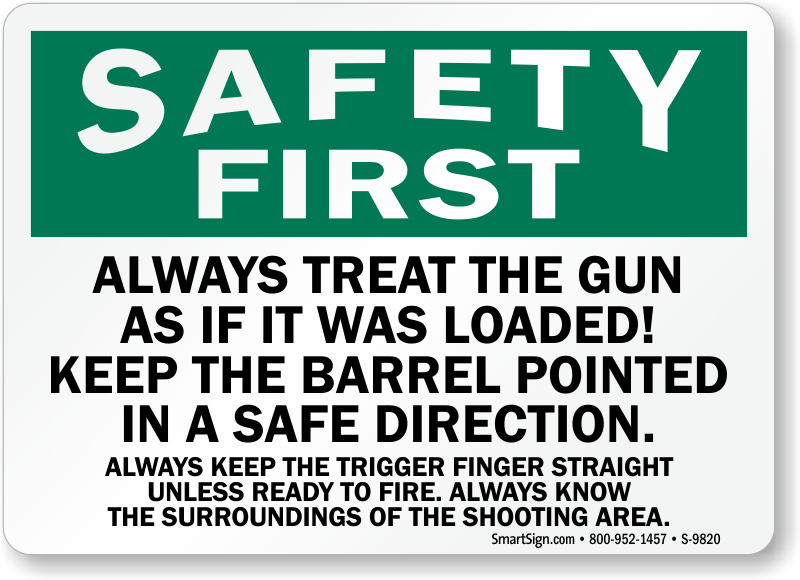
Gun safety rules and recommendations are intended to avoid accidental discharge or negligent discharge, or the consequences of firearm malfunctions. Their purpose is to eliminate or minimize the risks of unintentional death, injury or damage caused by improper possession, storage, or handling of firearms. There were 47,000 unintentional firearm deaths worldwide in 2013.[1]
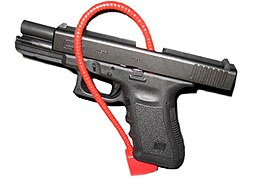
A Glock secured for transport (or storage) with a cable lock.
Contents
[hide]
Rules and mindset[edit]
Gun safety training seeks to instill a certain mindset and appropriate habits by following specific rules. The mindset is that firearms are inherently dangerous and must always be stored carefully and handled with care. Handlers are taught to treat firearms with respect for their destructive capabilities, and strongly discouraged from playing or toying with firearms, a common cause of accidents. The rules of gun safety follow from this mindset.
In 1902, the English politician and game shooting enthusiast Mark Hanbury Beaufoy wrote some much-quoted verses on gun safety, including many salient points. His verses “A Father’s Advice” begin with the following:[2][3]
If a sportsman true you’d be
Listen carefully to me:
Never, never, let your gun
Pointed be at anyone…
Ira L. Revees, in his 1913 book The A B C of Rifle, Revolver and Pistol Shooting,[4] stated the following:
- “The Accident-Proof Rule”:
- “The muzzle of a firearm should never point in a direction in which, if discharged, it would do injury where injury is not meant to be done.”
- “the companion rule of the one just given”:
- “All firearms are at all times loaded.”
- And he went on to say:
- “The trigger should never be pulled until the identity of the thing fired at has been established beyond any doubt.”
Various version of the “Ten Commandments of Gun Safety” have been published. This one is from the Sporting Shooters Association of Australia:[5]
- Treat every gun with the respect due a loaded gun.
- Carry only empty guns, taken down or with the action open, into your car, camp and home.
- Always be sure that the barrel and action are clear of obstructions.
- Always carry your gun so that you can control the direction of the muzzle.
- Be sure of your target before you pull the trigger.
- Never point a gun at anything you do not want to shoot.
- Never leave your gun unattended unless you unload it first.
- Never climb a tree or a fence with a loaded gun.
- Never shoot at a flat, hard surface or the surface of water.
- Do not mix gunpowder and alcohol.
Jeff Cooper, an influential figure in modern firearms training, formalized and popularized “Four Rules” of safe firearm handling. Prior lists of gun safety rules included as few as three basic safety rules or as many as ten rules including gun safety and sporting etiquette rules. In addition to Cooper, other influential teachers of gun safety include Massad Ayoob, Clint Smith, Chuck Taylor, Jim Crews, Bob Munden and Ignatius Piazza.
Jeff Cooper’s Four Rules:[6]
- All guns are always loaded.
- Never let the muzzle cover anything you are not willing to destroy.
- Keep your finger off the trigger until your sights are on the target.
- Be sure of your target and what is beyond it.
The National Rifle Association provides a similar set of rules:[7]
- ALWAYS keep the gun pointed in a safe direction.
- ALWAYS keep your finger off the trigger until ready to shoot.
- ALWAYS keep the gun unloaded until ready to use.
Project Appleseed provides similar rules for their rifle marksmanship clinics:[8]
- Always keep the muzzle in a safe direction.
- Do not load until given the load command.
- Keep your finger off the trigger until the sights are on the target.
- Make sure those around you follow the safety rules.
The Canadian Firearms Program uses the concept of The Four Firearm ACTS:[9]
- Assume every firearm is loaded.
- Control the muzzle direction at all times.
- Trigger finger off trigger and out of trigger guard.
- See that the firearm is unloaded. PROVE it safe.
Blank ammunition, which is a primed casing filled with gunpowder, either crimped or covered with a wad, is dangerous up to 15 feet. In the past, people have injured or killed themselves believing that blanks were not dangerous. Therefore, gun safety rules apply even to guns loaded with blanks.
Treat firearms as if they are loaded[edit]
|
This section does not cite any sources. (December 2012) (Learn how and when to remove this template message)
|
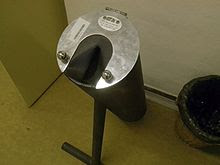
Barrel for dry firing, in order to ultimately check the unloaded state of a firearm
This rule is a matter of keeping a certain mindset. The purpose is to create safe handling habits, and to discourage reasoning along the lines of, “I know my gun is unloaded so certain unsafe practices are OK.” The proposition “the gun is always loaded” means that, even though it may be known that this is not true of a particular firearm, that knowledge is never trusted or relied upon. Thus even if the firearm turned out to be loaded when the handler thought it was not, treating it as loaded would avoid an “unintentional discharge”, and if one should occur anyway, avoiding damage, injury or death.
Many firearm accidents result from the handler mistakenly believing a firearm is emptied, safetied, or otherwise disabled when in fact it is ready to be discharged. Such misunderstandings can arise from a number of sources.
- Faulty handling of the firearm. A handler may execute the steps of procedures such as loading, firing and emptying in the wrong order or omit steps of the procedures.
- Misunderstandings about a firearm’s status. For instance, a handler may think the safety is on when it is not. A round of ammunition may be in the chamber or in the magazine while the handler thinks it is empty. A handler may receive a firearm and assume it is in a certain state without checking whether that assumption is true. For example, as handlers interact and pass the firearm between them, each avoids over-relying on the “show clear” of the other. Person 1 may misjudge the status; person 2 cannot assume that “it’s OK because person 1 already checked it.”
- Mechanical failures. Wear, faulty assembly, damage or faulty design of the firearm can cause it not to function as intended. For instance, a safety may have been worn down to a point where it is no longer functioning. Broken or worn parts in the trigger, sear or hammer/striker may have given the firearm a “hair trigger” (a very sensitive trigger). A dented or bent body of the firearm may cause jams or premature discharge of ammunition. Sensitivity to impact may cause a firearm to discharge if dropped or struck against another object.
If a handler always treats firearms as capable of being discharged at any time, the handler is more likely to take precautions to prevent an unintentional discharge and to avoid damage or injury if one does occur.[10]
Point the muzzle away from non-targets[edit]
This rule is intended to minimize the damage caused by an unintended discharge. The first rule teaches that a firearm must be assumed to be ready to fire. This rule goes beyond that and says, “Since the firearm might fire, assume that it will and make sure no harm occurs when it does.”
A consequence of this rule is that any kind of playing or “toying” with firearms is prohibited. Playfully pointing firearms at people or other non-targets violates this rule and is possibly an extreme endangerment to life and/or property. To discourage this kind of behavior, the rule is sometimes alternately stated, “Never point a firearm at anything unless you intend to destroy it.”.
Two natural “safe” directions to point the muzzle are up (at the sky) and down (at the ground). Both have their advantages and disadvantages. Firing at the ground may result in a ricochet or cause hazardous fragments to be flung at people or objects. Aiming upward eliminates this risk but replaces it with the risk that the bullet may cause damage when it comes down to the ground again. A bullet fired straight up only returns at the terminal velocity of the bullet.[11] However, a bullet fired at an angle not perfectly vertical will retain its spin on the way down and can attain much more lethal speeds.[12] Several accidents have reportedly been caused by discharging firearms into the air; although the evidence in a few such cases has been disputed,[11] a study by the Centers for Disease Control and Prevention found 43 likely cases of injury from falling bullets during 2004 New Year celebrations in Puerto Rico.[13] It is also possible that the muzzle will inadvertently be pointed at a non-target such as someone’s head or an aircraft.[14]
In cases where the firearm is being handled indoors, up and down may not be safe directions. For example, a bullet fired upward or downward may travel through the ceiling, floor and plenum between adjacent floors of a multi-story building. In indoor areas where firearms will be handled often, a suitably safe direction should be designated. Firing ranges often designate a direction in which it is safe to point a firearm; almost universally this is downrange into a backstop which is designed to contain bullets and eliminate potential ricochets. In armories or other areas where weapons must be handled, a container filled with sand known as a “clearing barrel” or “clearing can” is often used for this purpose; bullets unintentionally discharged into the barrel will be safely stopped and contained by the sand.
Keep fingers off the trigger[edit]
This rule is intended to prevent an undesired discharge. Normally a firearm is discharged by pressing its trigger. A handler’s finger may involuntarily move for any of several reasons: the handler is startled, a lack of full attention on body movements, physiological reasons beyond conscious control such as a spasm, stumbling or falling, or the finger being pushed by something (as when trying to holster a handgun with one’s finger on the trigger). Handlers are therefore taught to minimize the harmful effects of such a motion by keeping their finger off the trigger until the muzzle is pointing at the target and the handler wishes to discharge the firearm.
The trigger guard and area above the trigger of a firearm presents a natural point for a handler to keep their finger out straight alongside the weapon, so as not to violate this rule. Another recommendation is to keep the trigger finger above the trigger guard, so that there is less chance of the finger involuntarily slipping into the guard when startled.[15] A properly indexed trigger finger also helps remind the person holding the firearm of the direction of the muzzle.
In popular culture, such as movies and TV shows, this rule is often violated, even by characters who should be trained in gun safety such as military personnel or law enforcement officers.
Be sure of the target and of what is beyond it[edit]
|
This section does not cite any sources. (December 2012) (Learn how and when to remove this template message)
|
This rule is intended to eliminate or minimize damage to non-targets when a firearm is intentionally discharged. Unintended damage may occur if a non-target is misidentified as a target, if the target is missed, or if the bullet hits something or someone other than the intended target.
Handlers are taught that they must positively identify and verify their target. Additionally, they learn that even when firing at a valid target, unintended targets may still be hit, for three reasons:
- The bullet may miss the intended target and hit a non-target around or beyond the target.
- A non-target may pass in front of the target and be hit with a bullet aimed at the target.
- The bullet may pass through the intended target and hit a non-target beyond it, so called “overpenetration”.
Therefore, this rule requires a handler to “always be sure of your target; not just the target itself, but above, below, to the left, to the right, in front of, and behind the target”.
This may create situations that present dilemmas for a handler. Such situations are for instance a police officer in a riot, a civilian facing a possible intruder at night, or a soldier in a situation where civilians are near the enemy. Indecision or misjudgment of the handler’s abilities in such a situation may cause undesired outcomes, such as injury to the handler due to hesitation, or the handler violating rules of engagement and causing unintended damage.
Hunters are commonly prohibited from shooting across roads and trails, or after dusk and before dawn, due to the risk of inadvertently hitting an unintended target. All discharge of firearms is prohibited in some cities, in part due to the possibility of hitting unseen targets.
Training is used to minimize the risk of such outcomes. Target practice increases the precision with which the handler can discharge the firearm and thus increase the chances that the intended target is hit. Education about terminal ballistics gives the handler knowledge about the characteristics of a bullet after a target is hit. This knowledge coupled with insight into the handler’s own capabilities makes it easier for the handler to make appropriate decisions about whether to discharge or not, even if given little time and/or put under severe stress.
Ammunition can be chosen to reduce the risk of overpenetration; see Terminal ballistics, Stopping power, and Hollow point bullet.
Range safety rules[edit]
Ranges and organized shoots may impose additional safety rules on participants. For example, at its marksmanship clinics, Project Appleseed requires that a range safety officer (RSO) uses a weed trimmer line to check each rifle’s bore for obstructions prior to its first use for the day. Six steps are then always followed when a round of shooting is complete and the line is ready to go “cold” to allow posting or checking targets, or when a rifle is ready to be removed from the line: 1) magazine out; 2) bolt back; 3) safety on; 4) chamber flag in; 5) ground the rifle; 6) step back; no one touching the rifle.
Open bolt indicators, or chamber flags, such as the yellow safety flag distributed by the Civilian Marksmanship Programor the green chamber flag distributed by Project Appleseed may be required to be inserted in the chamber to show the chamber is empty.
Ranges may limit the type of ammunition used, such as prohibiting the use of incendiary, tracer, or armor-piercing rounds, or more powerful rounds than a range is equipped to handle.[16][17] They may require the use of ear and eye protection.[17] Alcohol is commonly forbidden. Some ranges impose a waiting period for shooters who wish to rent a firearm, or require them to bring a friend, in order to reduce the incidence of suicides.[18][19] Ranges are advised to designate a range safety officer to enforce these rules.[17]
Ranges must be designed with safety in mind, including the use of proper backstops for the intended type of shooting.[17]
Malfunctions[edit]
|
This section needs additional citations for verification. (June 2015) (Learn how and when to remove this template message)
|
Firearm malfunctions may be caused by the primer and/or powder, by mechanical failures, or by mishandling.
Failure to fire malfunctions[edit]
Malfunctions associated with the firing pin of a firearm, or with the primer and/or powder within a cartridge include failures to discharge (misfires, “duds”), delayed discharge (hang-fires), and incomplete or insufficient discharge (squibs). A misfire is when the cartridge does not fire after it is struck by the firing pin. A hangfire is when the firing pin strikes the cartridge, but there is a delay of some seconds before the cartridge finally fires. A squib is when an underpowered round is fired, perhaps with an insufficient amount of powder in the case, and the bullet lodges in the bore. If the firearm is fired again, the barrel can peel back, severely damaging the weapon and injuring the shooter.
In each case, the shooter should wait for a period of time, commonly recommended between 25 seconds, up to two minutes, with the firearm pointed in a safe direction, then carefully remove the magazine, extract any mis-fed or misfired cartridge(s), and, with the breech opened carefully, check to ensure there is not a bullet or other obstruction lodged in the bore of the barrel. If there is an obstruction, and a subsequent round is fired, the firearm can fail explosively resulting in serious injury. Misfired rounds should be disposed of properly, usually in a special container for live ammo that failed to fire after ejecting round; such rounds should not be simply disposed of in the trash.
Mechanical malfunctions[edit]
Mechanical malfunctions of firearms include slamfires, jams, accidental release of the firing pin, and failure of the breech or barrel to contain the propellant.
A slam fire is when a cartridge fires immediately upon being chambered, before a trigger squeeze, and is most often caused by a floating firing pin that becomes obstructed by debris, or by an improperly raised primer that is installed on a cartridge case. A slam fire can also be caused by a softer primer being used than normally recommended.
Types of jams include failures to feed, extract, or eject a cartridge; failure to fully cycle after firing; and failure of a recoil- or gas-operated firearm to lock back when empty (largely a procedural hazard, as a “slide lock” is a visual cue that the firearm’s ammunition supply is empty). When a jam occurs, the handler should exercise extreme caution as a cartridge whose primer has been struck and which has been deformed in a jam can discharge unexpectedly (in a “hang-fire”.) One method of quickly clearing a jammed semi-automatic weapon is tap rack bang.
Firearms may also fire unintentionally for several reasons, including dropping the weapon or when a firearm receives any hard mechanical shocks. Similarly, unintentional firing may occur due to faulty triggers, or excessive heat buildup in the chamber which leads to the propellant cooking off. To prevent accidental firing when firearms are dropped or jarred, experts often suggest using modern firearm designs that have safety features such as a transfer bar or a firing pin blockwhich prevent the firing pin from striking the primer unless the trigger is squeezed. For older firearms without these features, experts suggest that they should be carried without a round in the chamber, or with the firing pin resting on an empty chamber in the case of revolvers.[20]
Firearms may undergo catastrophic failure (a “kaBoom” or “kB”) due to various causes, some caused by mishandling and others by poor design, weakened parts or the use of ammunition for which the firearm was not designed, but which will chamber and fire nonetheless.[21] Barrels may become blocked by foreign material, such as dirt, snow, or even water. For that reason, the muzzle should never be allowed to rest on the ground or allowed to accumulate precipitation. Another form of mishandling is the use of a cartridge that generates more pressure than the firearm was designed for. This can occur through faulty handloading, or the use of overpressure ammunition (+P or +P+) or magnum loads in firearms not rated for them.
Storage[edit]
Proper storage prevents unauthorized use or theft of firearms and ammunition, or damage to them.[22]
Gun safes[edit]
A ‘gun safe‘ or ‘gun cabinet’ is commonly used to physically prevent access to a firearm. Local laws may require particular standards for the lock, for the strength and burglar resistance of the cabinet, and may even require guns and ammunition to be stored separately.
Disassembly[edit]
Access to a functioning firearm can be prevented by keeping the firearm disassembled and the parts stored at separate locations. Sometimes, this rule is codified in law. For example, Swedish law requires owners of firearms either to store the entire firearm in a safe or lockable gun rack, or to lock the “vital piece” (bolt, etc.) away in a safe place.
Locks[edit]
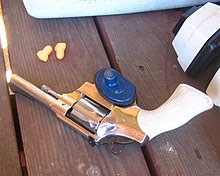
Trigger lock fitted to the trigger of a revolver
There are several types of locks that serve to make it difficult to discharge a firearm. Locks are considered less effective than keeping firearms stored in a lockable safe since locks are more easily defeated than approved safes. An unauthorized handler can bypass the locked firearm at their leisure.[22] Some manufacturers, such as Taurus, build locks into the firearm itself.
California effected regulations in 2000 that forced gun locks to be approved by a firearm safety device laboratory via California Penal Code Section 12088.[23] All gun locks under this code must receive extensive tests including saw, pick, pull, and many other tests in order to be approved for the state of California. If a lock passes the requirements then it is said to be California Department of Justice(CADOJ) approved.[24]
- Trigger locks
- Trigger locks prevent motion of the trigger. However, a trigger lock does not guarantee that the firearm cannot be discharged (see above). Some trigger locks are integrated into the design of the weapon, requiring no external parts besides the key. Generally, two pieces come together from either side behind the trigger and are locked in place, which can be unlocked with a key or combination. This physically prevents the trigger from being pulled to discharge the weapon. Other types of trigger locks do not go behind the trigger, but encompass the full area behind the trigger guard making the trigger inaccessible. Identilock is a gun attachment that completely covers and prevents access to the trigger, which makes it different from other trigger locks.
- There is controversy surrounding manufacturing standards, usage, and legislation of trigger locks. While supporters of trigger locks argue that they will save children from dying in gun accidents, critics point to demonstrations that some models can be removed by children with very little force and common household tools. Many firearms can go off if the gun is dropped. It is important to make sure to look for firearms that fully disengage the hammer when the safety is put on. A former senior product manager at Master Lock, a trigger lock manufacturer, was quoted as saying “If you put a trigger lock on any loaded gun, you are making the gun more dangerous.”[25] Critics also point out that a trigger lock will increase the time it takes a gun owner to respond to a self-defense emergency. In 2008, the U.S. Supreme Court overturned a Washington, D.C. law that required handguns to be locked or otherwise kept inoperative within the home, saying that this “makes it impossible for citizens to use them for the core lawful purpose of self-defense.”[26]
- Although there are no universal standards for the design or testing of trigger locks, some jurisdictions, such as the state of California, maintain a list of approved trigger lock devices.[27] In Canada, a trigger lock is one of the methods prescribed by law to secure a firearm during transport or storage.[28]
- Chamber locks
- Chamber locks aim to block ammunition from being chambered, since most firearms typically cannot be discharged unless the ammunition is in the correct position. They are used to prevent live ammunition from loading into a firearm by blocking the chamber with a dummy (fake) cartridge. The cartridge is sometimes wedged into place with the use of a tool, in essence jamming the gun. Another type is one in which a steel rod is locked into the safety cartridge with a key. As long as the rod and safety cartridge are engaged, the dummy round cannot eject nor can live ammunition be loaded into the firearm. Chamber locks work with most firearm types including revolvers, pistols,
rifles and shotguns. They are available in any caliber and length, and may include such features as unique keying, rapid removal, and rigorous testing and certification by major state departments such as the California Department of Justice.
- Cable locks
- Cable locks are a popular type of chamber lock that usually threads through the breech and ejection port of repeating-action firearms; they generally prevent full cycling of the action, especially preventing a return to “battery”, with the breech fully closed. In many designs of pistol and rifle, they also prevent the proper insertion of a magazine.
- Personalized guns, or smart guns, are intended to prevent unauthorized use with built-in locks that are released by RFID chips or other proximity devices, fingerprint recognition, magnetic rings, or a microchip implant.[29]
Ammunition storage[edit]
Some experts recommend storing ammunition in secure locations away from firearms.[30] Ammunition should be kept in cool, dry conditions free from contaminating vapors to prevent deterioration of the propellant and cartridge. Handloaders must take special precautions for storing primers and loose gunpowder.
Secondary dangers[edit]
|
This article needs additional citations for verification. (January 2011) (Learn how and when to remove this template message)
|
While a firearm’s primary danger lies in the discharge of ammunition, there are other ways a firearm may be detrimental to the health of the handler and bystanders.
Noise[edit]
When a firearm is discharged it emits a very loud noise, typically close to the handler’s ears. This can cause temporary or permanent hearing damage such as tinnitus. Hearing protection such as earplugs (disposable or reusable) and/or earmuffs (including electronic devices that amplify quiet sounds) can be used to reduce the risk of hearing damage.[22]Firearms may also be fitted with a Sound Suppressor which cools the gas emitting from the barrel to make the volume safe for the handler’s ears.
Hot gases and debris[edit]
A firearm emits hot gases, powder, and other debris when discharged. Some weapons, such as semi-automatic and fully automatic firearms, typically eject spent cartridge casings at high speed. Casings are also dangerously hot when ejected. Revolvers store spent casings in the chamber, but may emit a stream of hot gases and possible fine particulate debris laterally from the interface between the revolving chamber and the gun barrel. Any of these may hurt the handler or bystanders through burning or impact damage. Because eyes are particularly vulnerable to this type of damage, eye protection should be worn to reduce the risk of injury. Prescription lenses and various tints to suit different light conditions are available.[22] Some eye protection products are rated to withstand impact from birdshot loads, which offers protection against irresponsible firearms use by other game bird shooters.[31]
Toxins and pollutants[edit]
In recent years the toxic effects of ammunition and firearm cleaning agents have been highlighted.
- Lead ammunition left in nature may become mobilized by acid rain.
- Older ammunition may have mercury-based primers.
- Lead accumulates in shooting range backstops.
Indoor ranges require good ventilation to remove pollutants such as powder, smoke, and lead dust from the air around the shooters. Indoor and outdoor ranges typically require extensive decontamination when they are decommissioned to remove all traces of lead, copper, and powder residues from the area.
Lead, copper and other metals will also be released when a firearm is cleaned. Highly aggressive solvents and other agents used to remove lead and powder fouling may also present a hazard to health. Installing good ventilation, washing hands after handling firearms, and cleaning the space where the firearm was handled lessens the risk of unnecessary exposure.
Unsafe users[edit]
Impaired users[edit]
Firearms should never be handled by persons who are under the influence of alcohol or any drugs which may affect their judgment. Gun safety teachers advocate zero tolerance of their use.[32] In the United States, this recommendation is codified in many states’ penal codes as a crime of “carrying under the influence”, with penalties similar to DWI/DUI.[33]Other sources of temporary impairment include exhaustion, dehydration, and emotional stress. These can affect reaction time, cognitive processing, sensory perception, and judgment.
Many jurisdictions prohibit the possession of firearms by people deemed generally incapable of using them safely, such as the mentally ill or convicted felons.
Children[edit]
|
|
The examples and perspective in this section deal primarily with the United States and do not represent a worldwide view of the subject. (January 2012) (Learn how and when to remove this template message)
|
Children who are generally considered too young to be allowed to handle firearms at all can be taught a different set of rules:
- Stop.
- Don’t touch.
- Leave the area.
- Tell an adult.
The purpose of these rules is to prevent children from inadvertently handling firearms. These rules are part of the Eddie Eagle program developed by the National Rifle Association for preschoolers through 6th graders.[34]
Whether programs like Eddie Eagle are effective has not been conclusively determined. Some studies published in peer-reviewed journals have shown that it is very difficult for young children to control their curiosity even when they have been taught not to touch firearms.[35] Gun access is also a major risk factor for youth suicide.[36] The American Academy of Pediatrics (AAP) advises that keeping a gun in the home, especially a handgun increases the risk of injury and death for children and youth in the home.[37] If families do keep a gun in the home, the AAP advises keeping it unloaded and locked up, with the ammunition locked in a separate location, and the keys to the locked boxes hidden.[37]
Polling shows that over half of parents who do not own a gun have never talked with their children age 5-17 about gun safety.[38] The ASK Campaign (Asking Saves Kids) is based on the fact that many families with children have a gun, and almost half these guns are left unlocked or loaded. The ASK Campaign urges parents to ask their friends, neighbors and family members if they have an unlocked gun in the home before sending their children over to play.[39]
Older youth (age may vary per program, such as 12-18 year olds) may take part in a program for safe rifle handling, such as the ones promoted by these organizations:
- 4H Shooting Sports Programs
- Boy Scouts of America
- Civilian Marksmanship Program
- National Rifle Association
- Project Appleseed
See also[edit]
References[edit]
- Jump up^ GBD 2013 Mortality and Causes of Death, Collaborators (17 December 2014). “Global, regional, and national age-sex specific all-cause and cause-specific mortality for 240 causes of death, 1990-2013: a systematic analysis for the Global Burden of Disease Study 2013”. Lancet. 385 (9963): 117–71. doi:10.1016/S0140-
6736(14)61682-2. PMC 4340604  .
.PMID 25530442. - Jump up^ Rose, R. N. (November 22, 1956). The BEAUFOY VERSES, in The Field. Archived from the original on October 26, 2009. Retrieved 2008-06-29.
- Jump up^ Beaufoy, Gwendolyn (1930). Leaves from a Beech Tree.
- Jump up^ Reeves, Ira L. (1913). The A B C of Rifle, Revolver and Pistol Shooting. Kansas City, MO, USA: Franklin Hudson Publishing Company.
- Jump up^ “The Ten Commandments of Safety”. Sporting Shooters’ Association of Australia. Retrieved 28 January 2015.
- Jump up^ Morrison, Gregory Boyce (1991). Cooper, Jeff, ed. The Modern Technique of the Pistol. Paulden, Arizona, USA: Gunsite Press. ISBN 0-9621342-3-6. LCC
N 91072644. - Jump up^ “NRA Gun Safety Rules”. The National Rifle Association of America. 2009. Retrieved 2009-05-18.
- Jump up^ Ayoob, Massad (May–June 2010). “The Appleseed Project” (123). Backwoods Home Magazine.
- Jump up^ “The Vital Four ACTS of Firearm Safety”. Royal Canadian Mounted Police. 2004-01-23. Retrieved 2009-05-18.
- Jump up^ Gunsmithing Made Easy by Bryce M. Towsley pg 91
- ^ Jump up to:a b “Can a bullet fired into the air kill someone when it comes down?”. The Straight Dope. 1995-04-14.
- Jump up^ “Mythbusters Episode 50: Bullets Fired Up”. Mythbusters. 2006-04-19.
- Jump up^ “New Year’s Eve Injuries Caused by Celebratory Gunfire — Puerto Rico, 2003”. Centers for Disease Control and Prevention. 2004-12-24.
- Jump up^ “The Aviation Safety Network Website”. Aviation Safety Network. 2005-01-12. Retrieved 2009-05-18.
- Jump up^ Ayoob, Massad (January–February 2007). “The subtleties of safe firearms handling”. Backwoods Home Magazine. Retrieved December 22, 2015.
- Jump up^ “Range Safety Rules”. Florida Fish and Wildlife Conservation Commission. Retrieved 12 December 2014.
- ^ Jump up to:a b c d Whiting, Richard C. (1990). “Shooting Range Safety”. National Shooting Sports Foundation. Retrieved 12 December2014.
- Jump up^ Keegan, Kyle (January 23, 2014). “Suicidal customers see a way out at gun ranges”. Orange County Register. Retrieved 12 December 2014.
- Jump up^ Gibbons, Lauren (August 23, 2014). “Gun-range suicides infrequent but a concern”. The Columbus Dispatch.
- Jump up^ “The subtleties of safe firearms handling” Massad Ayoob, Backwoods Home Magazine, Issue #103, January/February 2007
- Jump up^ RCMP-GRC (2008). Canadian Firearms Safety Course (4th ed.). Royal Canadian Mounted Police. pp. 87–90. ISBN 978-0-660-
19826-2. - ^ Jump up to:a b c d Carolee Boyles. “Safety sells – safety devices for gun owners and their firearms”. Shooting Industry[permanent dead link]
- Jump up^ “Aroner-Scott-Hayden Firearms Safety Act of 1999”. State of California. 1999. Retrieved 2009-05-18.
- Jump up^ “Pro-Lok: Professional Quality Tools – CADOJ REGULATIONS”. PRO-LOK. 2007–2009. Retrieved 2009-05-18.
- Jump up^ Slater, Eric (February 16, 1999). “Hype Over Trigger Locks Provokes Fear of Firearm Accidents”. Los Angeles Times. Retrieved 2009-03-03.
- Jump up^ Egelco, Bob (June 27, 2008). “RULING’S RICOCHET – A right to own guns: Supreme Court defines 2nd Amendment – gun lobby expected to challenge S.F. ban on handgun possession in public housing”. San Francisco Chronicle. Retrieved 2009-03-03.
- Jump up^ California DOJ Bureau of Firearms (2008-05-06). “Approved Firearms Safety Devices Compability Chart” (PDF). Archived from the original (PDF) on 2008-07-09. Retrieved 2008-05-16.
- Jump up^ Royal Canadian Mounted Police. “Storing, Transporting, and Displaying Firearms”. Retrieved 2008-05-16.
- Jump up^ “No Chip in Arm, No Shot From Gun”. Wired.com. Retrieved 2012-08-04.
- Jump up^ GAO (1991). Accidental Shootings: Many Deaths and Injuries Caused by Firearms Could Be Prevented. p. 35. ISBN 9781568065533.
- Jump up^ Roy Huntington. “Gun safety & safety products”. Shooting Industry. Archived from the original on 2012-07-08.
- Jump up^ “Gun Safety Rules; Save a life by reading this page and give it to a friend”. www.SaveTheGuns.com. 2000–2009. Retrieved 2009-05-18.
- Jump up^ “MSP – Carrying Under the Influence”. State of Michigan. 2001–2009. Retrieved 2009-05-18.
- Jump up^ “Eddie Eagle Safety Program”. The National Rifle Association of America. 2009. Retrieved 2009-05-18.
- Jump up^ “Gun Safety for Kids and Youth – What if I’ve taught my kids not to touch a gun if they find one?”. University of Michigan Health System. 2010. Retrieved 2012-01-13.
- Jump up^ “Suicide-Proof Your Home”. The Center to Prevent Youth Violence. 2011. Retrieved 2012-01-13.
- ^ Jump up to:a b “Gun Safety: Keeping Children Safe”. The American Academy of Pediatrics. 2012. Retrieved 2012-01-13.
- Jump up^ “Gun Shy? 14 Million Parents Have Never Talked Gun Safety With Their Kids”. Archived from the original on 2014-04-07.
- Jump up^ “ASK (Asking Saves Kids)”. The Center to Prevent Youth Violence. 2011. Retrieved 2012-01-13.
External links[edit]
| Wikimedia Commons has media related to Firearm safety. |
- GunProof – Website dedicated to helping gun proof children.
- LOK-IT-UP – A public awareness program encouraging the safe storage of firearms.
- Controversy over exact choice of rules for gun safety (specifically whether or not “the gun is always loaded” is an intelligent rule).
- A Review of Gun Safety Technologies National Institute of Justice
- NRA Gun Safety Rules – Also deals with issues such as eye and ear protection.
- Project ChildSafe
- [1] – Educating parents who own, or do not own, guns about the importance of teaching gun safety.
- Canadian page about ACTS and PROVE
- How to Tell If Your Gun Is Loaded?
Movie clips of firearm accidents[edit]
Camping advice
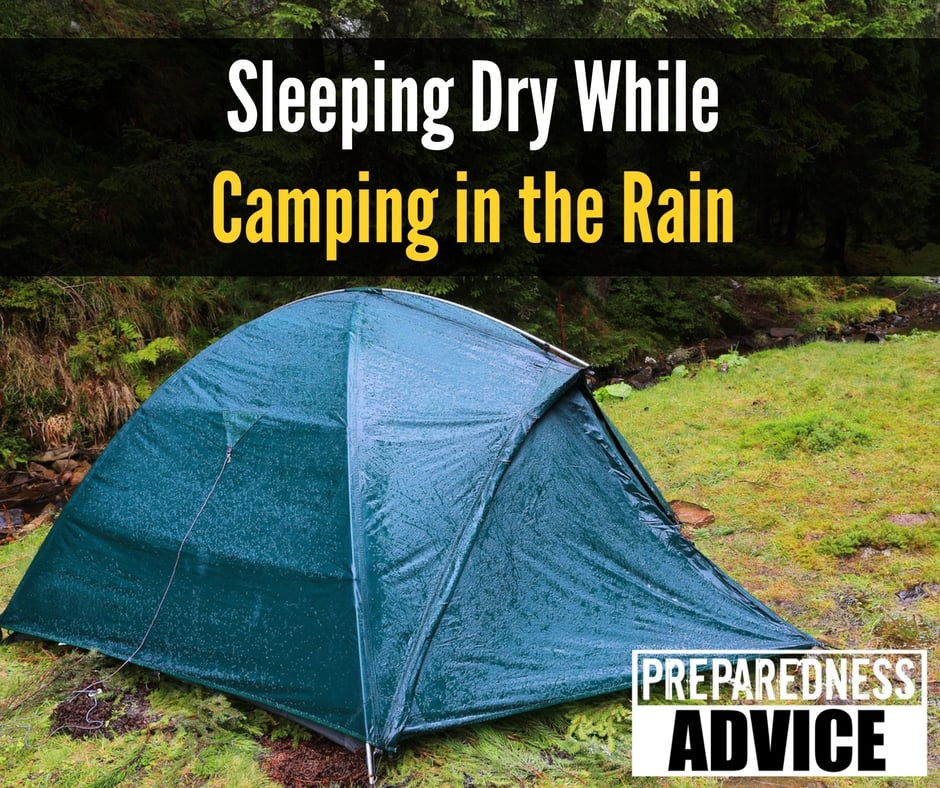
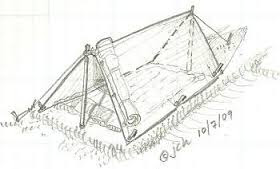
Here you can see the ditch going around the tent.
It has been raining hard on and off for the last several days. This resulted in a discussion about sleeping dry while camping in the rain. It’s surprising how little even experienced campers know about the subject, especially if they have generally camped during great weather or in drier locations. For them, the extent of their knowledge and preparedness comes down to depending on their tent alone to keep them dry.
Unless you want to end up with your gear soaked with water, soggy food, and wearing wet clothes, socks, and boots, here’s what you should know about sleeping dry.
There’s more to selecting a campsite than just a pretty view. You need to know how to How to Select a Campsite and have an understanding of how to build a drainage ditch around a tent if you suspect rain is in the forecast. Here are a few ideas to help you if you have to build a shelter in the rain and be sleeping dry even during a heavy downpour.
First, choose a high spot for your tent, and don’t pitch your tent in an indentation which will become a puddle if it rains. Make sure you have good drainage around your tent. Most newer tents are made tub-style, meaning the floor fabric comes up the wall several inches, even forming a lip at the door, with as few seams as possible. They claim that this will prevent water from coming into your tent even if you are sitting in a shallow puddle.
When we had tents without floors, the old-school style of directing rain away from your tent was to dig a ditch all around it. They tell me that this is no longer an acceptable practice for environmental reasons, and due to the style and materials of modern tents, no longer necessary.
I seriously question this, and in any type of a real survival situation, if rain is a problem, I will dig a shallow ditch around my tent and drain the water off to the downhill side. In the past, this method was taught by both the military and the boy scouts and is time-proven.
Personally, I’ve experienced a soaking wet tent, and it’s no fun. We have a Base Camp tent from REI, and although the overall quality is excellent, in no way is it waterproof, even with the rainfly if there’s enough rain.
So, if sleeping dry is a priority and rain is on the way, here’s how you can dig a drainage ditch around your tent.
-
-
- Dig the trench by cutting straight down just outside tent footprint. Do not dig in a V-shape. Slope the side away from the tent. Dig trench all around the tent
- Throw dirt from trench away from the tent; never throw it against the tent, for it will quickly rot the material.
- In most cases, do not dig trench more than 4 or 5 inches deep and in the shallowest place not over 3 inches. There should be enough slope in the trench so that the water will flow freely toward the outlet and not back up.
- To carry the water off, dig an outlet at the lowest point of the area and connect it to the trench which has been dug around the lent.
- When there is a possibility that the water may flow in from higher ground, dig a ditch to divert the water before it can reach the tent
-
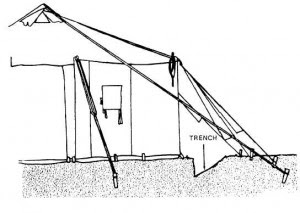
Here you can see a cross-section of the ditch
Whether you are using a tent, tarp or another improvised shelter, if possible always point the opening downhill. If you live in an area that is subject to heavy rains and plan to camp out, have good tents and extra tarps.
If you look at the homeless camps during wet weather, most tents will have a tarp over them and often under them. If you put a tarp under your tent, be sure you fold the ends underneath so nothing is sticking out. If any part of the tarp is sticking out, it will funnel the water underneath your tent.
If you don’t have a sleeping pad or something to raise your sleeping bag off the ground, cut some brush or dry grass if it is available and put some padding between you and the ground.
If you live in an area that is subject to rainy weather, go camping in the rain. Try different types of shelters and see what works for you. Not too many years ago I went camping and used my old tent and a friend with me used his brand new 400 dollar tent. Guess which one leaked? The new one. Sleeping dry requires practice. Be sure and test your gear.
I have been lucky enough to shot one of these. It was almost as fun as a Unannounced School day closure!
